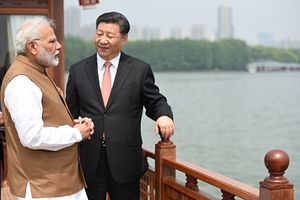A year after Doklam, India appears to be intent on seeking friendlier ties with Beijing. Whether this is sustainable for the long-term, however, is unclear. Even as this process has unfolded, India continues to worry about China’s activities in the neighborhood and continues to build up its ties with other partners, though cautiously.
Since April, there have been a series of meetings between the top Indian and Chinese leaders, Narendra Modi and Xi Jinping. After the “informal” summit in Wuhan in April, the two met on the sidelines of the Shanghai Cooperation Organization (SCO) summit in Qingdao in June and the BRICS leaders’ summit in Johannesburg in July.
At the Wuhan Summit, Modi and Xi agreed to the China-India Plus cooperation format to work in third countries such as Afghanistan. Thereafter, India’s Foreign Secretary Vijay Gokhale went on to develop an outline for a capacity-building project, which was announced on the sidelines of the SCO summit in Qingdao in June.
On October 15, India and China jointly began a training program for Afghan diplomats in New Delhi, a significant development. Chinese Ambassador to India Luo Zhaohui is reported to have said that the two countries should collaborate in other neighboring countries such as Iran, Nepal, and Myanmar. The 10 Afghan officers, on finishing the training at the Foreign Service Institute in India, will go to China for the second leg as part of the joint training program.
Though Afghanistan sent its diplomats for training under the program, the Afghan leadership is reportedly disappointed with India. Kabul is apparently of the view that because of India joining hands with China, there has been a downgrading of India’s assistance to Afghanistan to “smaller” projects as a way of assuaging Pakistan’s concerns. Reports indicate that “India had, in fact, conceded [to] China’s request to jointly implement a limited ‘capacity building’ project to opt for a smaller project in Afghanistan, possibly to assuage its ally Pakistan’s misgivings.”
India’s efforts to assuage China are not limited to Afghanistan alone. The two sides are slated to sign a bilateral internal security cooperation pact on October 22 during the visit of Zhao Kezhi, China’s minister of public security to India. Intelligence exchange, sharing of best practices, exchange programs, and cooperation in disaster mitigation are some of the areas the two sides intend to cooperate on under this agreement.
Quoting officials, reports suggest that this security cooperation arrangement could possibly lead to an agreement to exchange prisoners in each other’s countries. There are apparently 10 Indian prisoners is Chinese prisons and “an equal number of Chinese in Indian prisons as well,” according to the Financial Express. Chinese Foreign Minister Wang Yi is scheduled to come to India in December to co-chair a meeting that focuses on people-to-people ties, a decision that was taken by Modi and Xi in the wake of the Doklam crisis.
While New Delhi tries to address Beijing’s concerns, there are questions about how long all this will last, given that there seems to be no letup in the expansion of China’s military and diplomatic presence in India’s periphery. For instance, just as India and China started their joint training program for Afghan diplomats, China was busy deploying PLA Navy submarines in the Indian Ocean after a gap of more than a year. It has been reported that China had sent a Type 039A Yuan class SSK diesel submarine and submarine rescue vessel, which were sighted in the Indian Ocean earlier this month. This is the first such PLA Navy mission in the Indian Ocean since the Doklam crisis.
How India will respond remains to be seen. India’s Chief of Naval Staff Admiral Sunil Lanba recently said that India was “working with all like-minded nations and we are in dialogue with China as well.”
Meanwhile, China is also continuing to demonstrate its interest in pushing into India’s sphere of influence in Bhutan. Even though Beijing has no formal diplomatic ties with Thimphu, it has been expanding its footprint in Bhutan for a while now. Reports suggest that China has increased the number of shipments into Bhutan in the past decade, everything from machinery to cement to electrical equipment to toys to the point where China is now “the third largest source of foreign products” to Bhutan.
As India seeks better ties with China, it is also continuing to build up its partnerships in the region. India-Japan maritime cooperation saw a boost with the re-starting of the exercise, JIMEX that concluded earlier this week. India also held the inaugural 2+2 Dialogue with the United States last month and signed the Communications Compatibility and Security Agreement (COMCASA). India-Australia ties are also seeing some revival with a number of security dialogues and military exercises between the two sides.
On the other hand, in a demonstration of “strategic autonomy” from the United States, India has signed an agreement to purchase the S-400s anti-aircraft missiles from Russia and also plans to buy more oil from Iran from November, despite the threat of U.S. sanctions. Whether India can continue this high stakes strategic tightrope-walking remains to be seen.

































